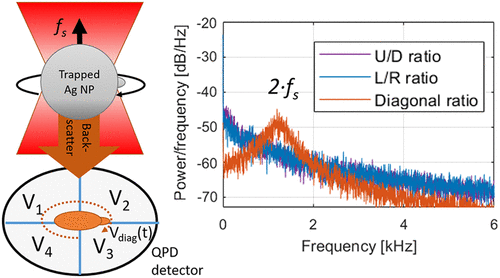当前位置:
X-MOL 学术
›
ACS Photonics
›
论文详情
Our official English website, www.x-mol.net, welcomes your
feedback! (Note: you will need to create a separate account there.)
Facile Measurement of the Rotation of a Single Optically Trapped Nanoparticle Using the Diagonal Ratio of a Quadrant Photodiode
ACS Photonics ( IF 6.5 ) Pub Date : 2021-11-02 , DOI: 10.1021/acsphotonics.1c00802 Yuval Yifat 1, 2 , John Parker 1, 3 , Tian-Song Deng 1 , Stephen K. Gray 4 , Stuart A. Rice 1, 5 , Norbert F. Scherer 1, 5
ACS Photonics ( IF 6.5 ) Pub Date : 2021-11-02 , DOI: 10.1021/acsphotonics.1c00802 Yuval Yifat 1, 2 , John Parker 1, 3 , Tian-Song Deng 1 , Stephen K. Gray 4 , Stuart A. Rice 1, 5 , Norbert F. Scherer 1, 5
Affiliation

|
Optical tweezers are a powerful tool for exploring physical properties of particles in various environments through analysis of their dynamics in a trapping potential. Analysis of the trapped particle’s position is often done using interferometric back-focal-plane detection microscopy in which interference between the trapping laser and the light interacting with the trapped particle is projected on a quadrant photo-diode (QPD). The QPD measurements are almost universally the voltage ratios between the transverse components of the detector (left/right; up/down) that are calibrated to ascertain particle positions and orientations (i.e., rotation). In this paper, we demonstrate how measuring the diagonal ratio of the QPD allows tracking the spinning and orbital motion of optically trapped objects with enhanced sensitivity compared to the conventional transverse ratio and reveals additional information about particle dynamics. The diagonal ratio “balances” the signal from opposite sides of the QPD, allowing common mode noise reduction and increased measurement sensitivity of the rotating nanospheres at frequencies from below 200 Hz to above 15 kHz. We show that the variability in particle rotation rates is due to slight differences in the aspect ratio of the nanoparticles. We also measure in situ a gradual acceleration in the spinning frequency of trapped nanoparticles due to photothermal shedding of surface ligands and the resulting decrease of rotational friction in solution. The accelerating particles spin at rates exceeding 30 kHz and are eventually “optically printed” onto the glass coverslip on top of the liquid cell enclosure. The diagonal ratio is a simple, readily available, and powerful enabler for measuring rotational dynamics with a 5-fold sensitivity increase over conventional QPD measurements. This affords opportunities for controlling the orientational dynamics of trapped nanoparticles, which is crucial for various applications, including nanoscale mechanical motors.
中文翻译:

使用象限光电二极管的对角线比轻松测量单个光学捕获纳米粒子的旋转
光镊是一种强大的工具,可以通过分析粒子在捕获势中的动力学来探索各种环境中粒子的物理特性。被困粒子位置的分析通常使用干涉式后焦平面检测显微镜来完成,在这种显微镜下,陷阱激光与与被困粒子相互作用的光之间的干涉被投射到象限光电二极管 (QPD) 上。QPD 测量几乎普遍是检测器的横向分量(左/右;上/下)之间的电压比,它们被校准以确定粒子位置和方向(即,旋转)。在本文中,我们演示了如何测量对角线比率与传统的横向比相比,QPD 允许以更高的灵敏度跟踪光学捕获物体的旋转和轨道运动,并揭示有关粒子动力学的附加信息。对角线比率“平衡”了来自 QPD 两侧的信号,从而降低了共模噪声并提高了旋转纳米球在 200 Hz 以下至 15 kHz 以上的频率下的测量灵敏度。我们表明,粒子旋转速率的可变性是由于纳米粒子的纵横比略有不同。我们还现场测量由于表面配体的光热脱落和溶液中旋转摩擦的减少,被捕获的纳米粒子的旋转频率逐渐加快。加速粒子以超过 30 kHz 的速度旋转,最终“光学打印”到液体池外壳顶部的玻璃盖玻片上。对角线比率是一种简单、容易获得且功能强大的推动因素,用于测量旋转动力学,其灵敏度比传统 QPD 测量提高 5 倍。这为控制被捕获的纳米粒子的定向动力学提供了机会,这对于包括纳米级机械马达在内的各种应用至关重要。
更新日期:2021-11-17
中文翻译:

使用象限光电二极管的对角线比轻松测量单个光学捕获纳米粒子的旋转
光镊是一种强大的工具,可以通过分析粒子在捕获势中的动力学来探索各种环境中粒子的物理特性。被困粒子位置的分析通常使用干涉式后焦平面检测显微镜来完成,在这种显微镜下,陷阱激光与与被困粒子相互作用的光之间的干涉被投射到象限光电二极管 (QPD) 上。QPD 测量几乎普遍是检测器的横向分量(左/右;上/下)之间的电压比,它们被校准以确定粒子位置和方向(即,旋转)。在本文中,我们演示了如何测量对角线比率与传统的横向比相比,QPD 允许以更高的灵敏度跟踪光学捕获物体的旋转和轨道运动,并揭示有关粒子动力学的附加信息。对角线比率“平衡”了来自 QPD 两侧的信号,从而降低了共模噪声并提高了旋转纳米球在 200 Hz 以下至 15 kHz 以上的频率下的测量灵敏度。我们表明,粒子旋转速率的可变性是由于纳米粒子的纵横比略有不同。我们还现场测量由于表面配体的光热脱落和溶液中旋转摩擦的减少,被捕获的纳米粒子的旋转频率逐渐加快。加速粒子以超过 30 kHz 的速度旋转,最终“光学打印”到液体池外壳顶部的玻璃盖玻片上。对角线比率是一种简单、容易获得且功能强大的推动因素,用于测量旋转动力学,其灵敏度比传统 QPD 测量提高 5 倍。这为控制被捕获的纳米粒子的定向动力学提供了机会,这对于包括纳米级机械马达在内的各种应用至关重要。











































 京公网安备 11010802027423号
京公网安备 11010802027423号